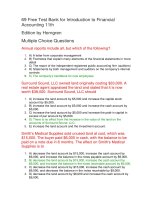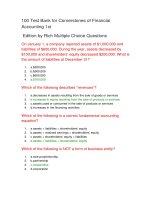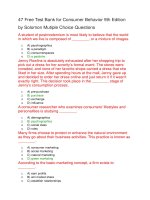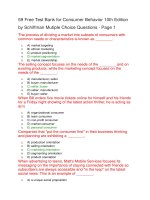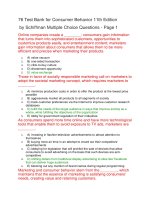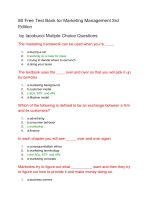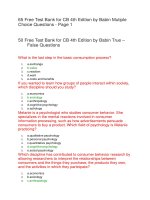174 test bank for organizational behavior 3rd edition hitt đề thi trắc nghiệm
Bạn đang xem bản rút gọn của tài liệu. Xem và tải ngay bản đầy đủ của tài liệu tại đây (177.54 KB, 37 trang )
174 Test Bank for Organizational Behavior 3rd Edition
Hitt
Multiple Choice Questions - Page 1
Diversity Management Programs create:
1.
A) an exclusive work environment
2.
B) an inclusive work environment
3.
C) unrealistic work environments
4.
D) realistic work environments
5.
E) inconsistent work environments
In a truly inclusive workplace, everyone feels________.
1.
A) motivated
2.
B) valued
3.
C) unmotivated
4.
D) under-valued
5.
E) both A and B
AAPs are specific measures an organization takes to
______discrimination.
1.
A) enhance
2.
B) remedy
3.
C) prevent
4.
D) both A and C
5.
E) Both B and C
Plural organizations have:
1.
A) consistent workforces
2.
B) diverse workforces
3.
C) homogeneous workforces
4.
D) Both A and C
5.
E) Both B and C
Because of effective group management of diversity, there is
1.
A) inconsistency with regard to group conflict
2.
B) consistent group conflict
3.
C) little intergroup conflict
4.
D) effective group conflict
5.
E) absolutely no group conflict
Diversity Management Programs:
1.
A) have on-going timeframes.
2.
B) have temporary timeframes.
3.
C) have timeframes that are in flux
4.
D) have timeframes that are inconsistent
5.
E) have timeframes that vary
Diversity Management Programs:
1.
A) attempt to uncover the root causes of diversity problems.
2.
B) do not attempt to uncover the root causes of diversity problems.
3.
C) can sometimes uncover the root causes of diversity problems.
4.
D) are not aimed at uncovering the root causes of diversity problems
5.
E) are not relevant to diversity root causes.
Diversity Management Programs create an environment where:
1.
A) all associates will be stifled
2.
B) all associates are allowed to reach their full potential
3.
C) all associates’ growth will be compromised
4.
D) all associates can choose to grow
5.
E) none of the above
Diversity is a ____________characteristic.
1.
A) general
2.
B) specific
3.
C) group
4.
D) individual
5.
E) orientation
________of human resource managers at Fortune 1000 companies said
they believed that successfully managing diversity improves their
organizations.
1.
A) 10 percent
2.
B) 20 percent
3.
C) 25 percent
4.
D) Under 25 percent
5.
E) Over 79 percent
A central feature of an AAP is
1.
A) a utilization analysis.
2.
B) an unspecific target.
3.
C) a hiring quota.
4.
D) an implemented target program.
5.
E) a rationale analysis
Diversity Management Programs:
1.
A) do not assume the organization will change
2.
B) do not assume that the managers will change
3.
C) assume that the organization will change
4.
D) assume that the managers will change
5.
E) Both C and D are correct
AAPs usually provide______action/changes.
1.
A) long-term
2.
B) sustainable
3.
C) temporary
4.
D) fixed
5.
E) concrete
Affirmative Action Programs:
1.
A) do not address the cause of problems.
2.
B) address the cause of problems
3.
C) look in detail at the causes of diversity problems
4.
D) are inconsistent in addressing the cause of problems
5.
E) none of the above
A multicultural organization:
1.
A) values differences
2.
B) fosters differences
3.
C) does not value differences
4.
D) does not foster differences
5.
E) Both A and B are correct
All of the following are dimensions of diversity except:
1.
A) social class
2.
B) age
3.
C) geographical background
4.
D) personality
5.
E) all of the above are dimensions of diversity
The most common dimension(s) of diversity is/are
1.
A) gender
2.
B) race
3.
C) ethnicity
4.
D) age
5.
E) all of the above
Most organizations in the United States are
1.
A) multicultural organizations
2.
B) plural organizations
3.
C) monolithic organizations
4.
D) both A and B
5.
E) both B and C
Affirmative Action Programs focus on:
1.
A) mobility
2.
B) retention
3.
C) recruitment
4.
D) A, B and C are correct
5.
E) None of the above
Monolithic organizations are:
1.
A) heterogeneous
2.
B) lacking segregation
3.
C) homogeneous
4.
D) self-promoting
5.
E) proactive
In practice, diversity is often defined in terms of _________dimensions.
1.
A) particular
2.
B) general
3.
C) whole
4.
D) temporary
5.
E) none of the above
Affirmative Action Programs:
1.
A) target women
2.
B) target people with disabilities
3.
C) target ethnic minorities
4.
D) target racial minorities
5.
E) All of the above
People of all genders, races, ethnicities, and cultural backgrounds are
integrated and represented at Google. Google is an example of a
____________.
1.
A) multicultural organization
2.
B) segregated organization
3.
C) monolithic organization
4.
D) homogenous organization
5.
E) plural organization
In the United States, federal contractors with 50 or more employees and
government contracts of $50,000 or more) _________ AAPs.
1.
A) can opt to have
2.
B) can voluntarily to decide to have
3.
C) are required to have
4.
D) are not required to have
5.
E) none of the above
Many individuals feel most comfortable interacting and working with
people who are ____________on a variety of dimensions.
1.
A) truthful
2.
B) pleasant
3.
C) intelligent
4.
D) similar to them
5.
E) dissimilar to them
Diversity Management Programs:
1.
A) target some associates
2.
B) target some of the more prominent associates
3.
C) target all associates
4.
D) target the seasoned associates
5.
E) target the underrepresented associates
Many organizations have _________ diversity management programs.
1.
A) been forced to adopt
2.
B) voluntarily adopted
3.
C) scorned
4.
D) turned their back on
5.
E) both A and C
_________can be defined as a characteristic of a group where differences
exist on one or more relevant dimensions.
1.
A) Orientation
2.
B) Diversity
3.
C) Inter-personal differences
4.
D) Intra-personal differences
5.
E) Intra-group differences
When diversity is managed successfully, a ________organization is the
result.
1.
A) high performance
2.
B) fully functioning
3.
C) multicultural
4.
D) competitive
5.
E) consistent
AAPs represents:
1.
A) American Association of Programs
2.
B) Associated Action Programs
3.
C) Affirmative Action Programs
4.
D) Affirmative Association Programs
5.
E) None of the above
Plural organizations take steps to be:
1.
A) exclusive
2.
B) inclusive
3.
C) homogenous
4.
D) Both A and C
5.
E) Both B and C
Affirmative Action Programs:
1.
A) assume individuals will assimilate into the organization
2.
B) assume individuals will not assimilate into the organization
3.
C) assume that it is the individual’s choice to assimilate into the organization
4.
D) assume most individuals will not choose to assimilate into the organization
5.
E) None of the above
69 Free Test Bank for Organizational Behavior 3rd
Edition Hitt Multiple Choice Questions - Page 2
U.S. federal laws prohibit employers from discriminating against
employees or applicants on the basis of:
1.
A) national origin
2.
B) religion
3.
C) disability
4.
D) color
5.
E) All of the above
Diversity alone _______________good corporate performance.
1.
A) can predict
2.
B) does not guarantee
3.
C) always predicts
4.
D) sometimes predicts
5.
E) none of the above
As globalization increases, the need for__________increases.
1.
A) affirmative action programs
2.
B) diversity management
3.
C) brainstorming
4.
D) climate oriented teamwork
5.
E) Both C and D
A criterion for effective diversity management calls for:
1.
A) the involvement of some associates
2.
B) the involvement of all associates
3.
C) the involvement of upper management
4.
D) the involvement of middle management
5.
E) none of the above
Racism, sexism, and homophobia are examples of:
1.
A) prejudice
2.
B) stereotypes
3.
C) discrimination
4.
D) Both A and C
5.
E) Both A and B
______________is status and power that is assigned by cultural norms
and depends on group membership.
1.
A) Group status
2.
B) Ascribed status
3.
C) Assigned status
4.
D) Member status
5.
E) None of the above
Assigning people with disabilities to easier jobs than other employees is
an example of:
1.
A) a stereotype
2.
B) discrimination
3.
C) prejudice
4.
D) Both A and B
5.
E) Both A and C
Companies that have paid out millions of dollars as a result of
discrimination lawsuits include:
1.
A) Target and Honda
2.
B) Wal-Mart and Texaco
3.
C) Google and Pepsi
4.
D) BP and Costco
5.
E) none of the above
Monolithic organizations tend to have:
1.
A) extreme occupational segregation
2.
B) a lack of occupational segregation
3.
C) inconsistent occupational segregation
4.
D) a tolerance for some occupational segregation
5.
E) none of the above
.____________occurs when people believe themselves not to be racists.
1.
A) Current racism
2.
B) Adaptive racism
3.
C) Modern racism
4.
D) Inconsistent racism
5.
E) Subtle racism
The U.S. Bureau of Labor Statistics has predicted that the number of
service producing jobs:
1.
A) will decrease in the coming years
2.
B) will increase in the coming years
3.
C) remain the same in the coming years
4.
D) be inconsistent in the coming years
5.
E) be unpredictable in the coming years
The Equal Pay Act of 1963 applies to:
1.
A) only some employers
2.
B) virtually all employers
3.
C) non-profit employers
4.
D) for profit only employers
5.
E) A and D
The Age Discrimination in Employment Act of 1967 applies to:
1.
A) private employers
2.
B) state employers
3.
C) government employers
4.
D) education institutions
5.
E) All of the above are correct answers
The proportion of men and women in the U.S population is expected to:
1.
A) remain stable in the coming years.
2.
B) increase in the coming years
3.
C) decrease in the coming years
4.
D) be inconsistent in the coming years
5.
E) none of the above
The three key ingredients in a successful diversity program include
commitment by the organization’s leaders, integration of the program with
the organization’s strategic plan, and _____________ .
1.
A) involvement of all associates
2.
B) accountability of associates
3.
C) external rewards for efforts
4.
D) resistance from all associates
5.
E) all of the above are correct
________are groups that share common interests and serve as a
mechanism for the ideas and concerns of associates to be heard by
managers.
1.
A) Affinity groups
2.
B) Ascribed groups
3.
C) Appointed groups
4.
D) Collaborative groups
5.
E) Interest groups
In some instances, ___________ prejudice and discrimination towards
minorities has been replaced by __________ racism.
1.
A) past, present racism
2.
B) overt, modern racism
3.
C) covert, subtle racism
4.
D) quiet, interracial racism
5.
E) none of the above
Diversity management programs should also be sensitive to the needs of:
1.
A) groups of disenfranchised associates
2.
B) individuals who are in the minority
3.
C) individuals who have been treated unfairly
4.
D) special interest groups
5.
E) individuals who are in the majority
Over the past ten years, more than __________of the people entering the
U.S. workforce have been members of racial or ethnic minority groups.
1.
A) ¾
2.
B) 2/3
3.
C) ½
4.
D) 1/3
5.
E) One percent
__________is behavior that results in unequal treatment of individuals
based on group membership.
1.
A) A stereotype
2.
B) Prejudice
3.
C) Discrimination
4.
D) Both A and B
5.
E) Both A and C
U.S. federal laws prohibit employers from discriminating against
applicants or employees on the basis of:
1.
A) age
2.
B) gender
3.
C) race
4.
D) color
5.
E) All of the above
Title I of the Americans with Disabilities Act of 1990 applies to:
1.
A) private employers
2.
B) state employers
3.
C) education employers
4.
D) government employers
5.
E) All of the above are correct answers
____________is a generalized set of beliefs about the characteristics of a
group of individuals.
1.
A) Prejudice
2.
B) Discrimination
3.
C) A stereotype
4.
D) Both A and C
5.
E) Both B and C
Having diverse teams allows for:
1.
A) homogeneous effects
2.
B) synergistic effects
3.
C) inconsistent effects
4.
D) unpredictable effects
5.
E) Both C and D
._____________is defined as a person’s knowledge that he belongs to
certain social groups, where belonging to those groups has emotional
significance.
1.
A) Individual identity
2.
B) Social identity
3.
C) Intra-group identity
4.
D) Inter-group identity
5.
E) Both A and C
.________can be a roadblock to establishing an effective diversity
environment.
1.
A).The willingness to openly disagree
2.
B) The way agreement is defined
3.
C) Communication
4.
D) The willingness to speak assertively
5.
E) Both A and D
U.S. federal laws prohibit discriminating anyone who is___old or older.
1.
A) 21 years
2.
B) 35 years
3.
C) 40 years
4.
D) 50 years
5.
E) 60 years
.Stereotypes tend to be:
1.
A) an enduring human quality
2.
B) an inconsistent human quality
3.
C) a temporary human quality
4.
D) a rational human quality
5.
E) Both B and C
_________occur when two or more dimensions of diversity are correlated.
1.
A) Predictions
2.
B) Fault lines
3.
C) Correlated barriers
4.
D) Corporate dimensions
5.
E) Both C and D
Statistics suggest that by the year 2050 ______ in every five Americans
will be ________ years old or older.
1.
A) two, 65
2.
B) three, 62
3.
C) four, 62
4.
D) one, 65
5.
E) none of the above answers is correct
.The first criterion for having an effective diversity program is:
1.
A) genuine commitment
2.
B) an assigned status
3.
C) a group identity
4.
D) to have an initiative
5.
E) Both C and D
The proportion of racial and ethnic minorities in the workforce is expected
to:
1.
A) level off in the coming years
2.
B) decrease in the coming years
3.
C) remain the same in the coming years
4.
D) stagnate in the coming years
5.
E) increase indefinitely in the coming years
When people feel that they have been treated unfairly, they react by:
1.
A) withdrawing
2.
B) performing poorly
3.
C) retaliating
4.
D) filing lawsuits
5.
E) All of the above are correct
The percentage of black Americans in the U.S. is expected to:
1.
A) level off in the coming years
2.
B) decrease in the coming years
3.
C) remain stable in the coming years
4.
D) stagnate in the coming years
5.
E) increase indefinitely in the coming years
The typical composition of corporate boards of directors in the U.S.
suggests or reflects:
1.
A) under-representation of women and minorities
2.
B) lack of representation of minority women, Asian-Americans, and Hispanics
3.
C) recycling of the same minority individuals
4.
D) very few boards have representation from all minority groups
5.
E) All of the above are correct answers
_____________are where the variety of team experiences, attitudes and
viewpoints leads to better team performance.
1.
A) Synergistic effects
2.
B) Collaborative staging effects
3.
C) Brainstorming staging effects
4.
D) Perceptive collaborative efforts
5.
E) Both B and C
_________refers to unfair negative attitudes we hold about people who
belong to social or cultural groups other than our own.
1.
A) stereotypes
2.
B) prejudice
3.
C) discrimination
4.
D) Both A and C
5.
E) Both A and B
True - False Questions - Page 1
Monolithic organizations are homogeneous.
1.
True
2.
False
AAPs stand for Affirmative Action Programs
1.
True
2.
False
Diversity can be defined as a characteristic of one individual where the
difference exists on only one dimension.
1.
True
2.
False
AAPs do not address the cause of discrimination problems.
1.
True
2.
False
In the U.S. federal contractors with 50 or more employees are not required
to have AAPs.
1.
True
2.
False
Personality is considered a dimension of diversity.
1.
True
2.
False
Harassment of various forms often leads to turnover and performance
issues.
1.
True
2.
False
Over the past ten years more than 75% of people entering the U.S.
workforce have been members of racial or ethnic minority groups.
1.
True
2.
False
A multicultural organization fosters and values differences.
1.
True
2.
False
AAPs assume individuals will individually assimilate into the organization.
1.
True
2.
False
Most organizations in the U.S. are multicultural organizations.
1.
True
2.
False
Important characteristics related to diversity include any characteristic
that may influence a person’s identity or the way in which he or she views
the world.
1.
True
2.
False
AAPs are ongoing and create permanent changes.
1.
True
2.
False
Plural organizations foster and value diversity.
1.
True
2.
False
Diversity Management Programs attempt to uncover the root causes of
diversity problems.
1.
True
2.
False
Plural organizations tolerate diversity and do not foster or value it.
1.
True
2.
False
Diversity is a group characteristic, not an individual characteristic.
1.
True
2.
False
Diversity Management Programs apply to only some associates.
1.
True
2.
False
Plural organizations do not take steps to be inclusive.
1.
True
2.
False
Monolithic organizations tend to have extreme occupational segregation.
1.
True
2.
False
Diversity Management Programs are only temporary programs.
1.
True
2.
False
The purpose of Diversity Management Programs is to allow all associates
to reach their full potential.
1.
True
2.
False
AAPs focus on recruitment, mobility and retention of employees.
1.
True
2.
False
Geographic background is not considered a dimension of diversity.
1.
True
2.
False
Many organizations have voluntarily adopted diversity management
programs.
1.
True
2.
False
Unintentional discrimination against individuals who have religious
practices that differ from those of the majority is most likely to occur in
plural organizations.
1.
True
2.
False
Affirmative Action Programs often require hiring quotas or lowered
standards for selection and promotion of women and minorities.
1.
True
2.
False
Google is an example of a monolithic organization.
1.
True
2.
False
The case study regarding the female firefighter at the Los Angeles Fire
Department resulted in discrimination.
1.
True
2.
False
A majority of human resource managers in Fortune 1000 companies said
that the successful management of diversity has a positive effect on
corporate outcomes.
1.
True
2.
False
Plural organizations have diverse workforces.
1.
True
2.
False
Diversity management programs can be aimed at recruiting and
motivating high-quality associates.
1.
True
2.
False
Diversity Management Programs create an inclusive work environment.
1.
True
2.
False
Most people feel more comfortable interacting and working with people
who are different to them on a variety of dimensions.
1.
True
2.
False
69 Free Test Bank for Organizational Behavior 3rd
Edition Hitt True - False Questions - Page 2
Social identity “in-group” and “out-group” dynamics are likely to enhance
successful diversity management.
1.
True
2.
False
The diversity found in the Obama administration reflects the diversity
found in corporate America.
1.
True
2.
False
The Age Discrimination in Employment Act of 1967 prohibits
organizations from discriminating against individuals over the age of 55.
1.
True
2.
False
By the year 2050 one in every five Americans will be 65 years old or
younger.
1.
True
2.
False
Differences in communication preferences is seldom a roadblock to
establishing an effective diversity environment.
1.
True
2.
False
To create a truly inclusive environment, diversity programs need to teach
people how to tolerate diversity.
1.
True
2.
False
Having diverse teams may allow for synergistic effects.
1.
True
2.
False
Companies that have a reputation for a sensitive and caring culture that
embraces diversity are likely to attract more applicants, thus increasing
the likelihood of hiring more talented associates.
1.
True
2.
False
In the next decade, the percentage of women entering the workforce is
likely to be greater than the percentage of men.
1.
True
2.
False

